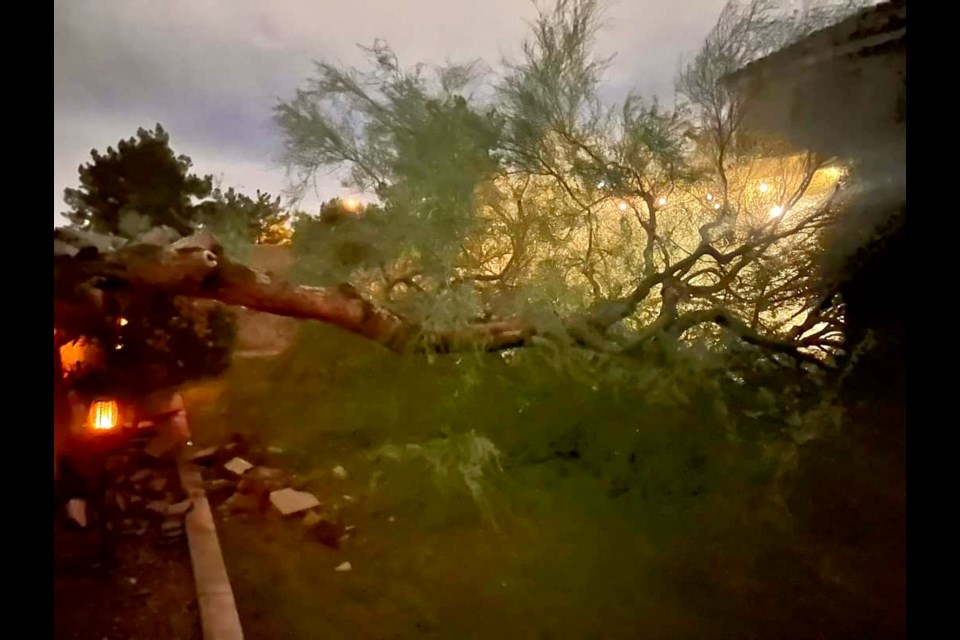Monsoon season officially started June 15, which means the heavy rains and high winds are right around the corner.
Before the storm season kicks into high gear, it is a good idea to get your property ready. Two key areas you want to prepare are your yard and your roof.
Following these few simple steps will help keep your property safe from the monsoon storms this summer.
Identify the drainage style for your property
Across the Valley there are typically two styles of properties, self-retention and U-drain lots. Most homeowners of recently built homes will have a property consisting of a U-drain lot. U-drain is the way the yard’s drainage system works. These lots are higher at the back end of the property line so the water will flow into a swale that collects in the backyard and drains down the side yards to the front eventually reaching the storm drains.
Self-retention lots are usually seen in areas with older homes with larger lots. Instead of draining from the back, down the sides of the home to the storm drain, self-retention lots must retain every drop of water that falls onto the property. These lots have their own retention basins that allow for water drainage.
It is important to know which style lot you have when building structures or walls around your home. If you’re not careful you can build a structure that impedes the flow of water. Many times, people will build a wall to block off the trash cans or air conditioning unit from being seen. These walls are built into the ground and disrupt the natural flow of water off the property. So before building anything on your lot be sure to know which style of drainage your yard has and if you aren’t sure hire a professional to inspect your yard.
Create a dry creek bed
As the name implies, dry creek beds become a flowing creek when the rains come. Also known as an arroyo, a dry creek bed is a shallow trench filled with rock or stone. Arroyos are designed to control the flow of water quickly and safely through your property.
Arroyos allow for rainwater to move easily through your landscaping without causing erosion to the soil. The water will flow from the arroyo to your drainage area away from the home and off your property. These dry creek beds not only provide a practical way to help with water flow but are a great addition to your desert backyard. Add plants and shrubs along the arroyo and you will have a beautiful focal point for your yard.
Use the right plants
Many desert plants are great for absorbing ground water. Create a garden or build flower beds in your backyard to help soak up some of that rainwater. Perennials, shrubs and cacti are all great for absorbing water out of the ground. If you have the means Saguaros are great at soaking up ground water. Saguaros will extend their roots across your yard to find water and once that water is gone the roots will die off. Grass is another option but here in the Valley water is precious and keeping your lawn watered so it doesn’t die outside of monsoon season can be costly.
Check your irrigation system
Irrigation systems are great for keeping your plants watered outside of monsoon season. Most irrigation systems have timers or settings where you can control how much water they use and how often they turn on. During monsoon season it is best to cut back on your irrigation system usage. When the storms start the Valley often sees rain once every few days. So, check the forecast in your area to see when you might be getting rain and schedule your irrigation appropriately. This will also help you save money on your water bill.
Install, clear out gutters
Many homes in the Valley have tile roofs without gutters. Installing gutters helps immensely when it comes to directing water flowing from your roof during a storm. If you do not have gutters now is the best time to install them before the rain comes. Pat Overson, of Overson Roofing in Mesa, said when installing your gutters, you must make sure the downspouts are positioned correctly for proper drainage.
“When installing your gutters, the downspouts need to be positioned so the water moving through the gutters will flow away from your home and into the drainage basin,” Overson said. “Always direct the water away from your house because with the amount of rain these storms produce can cause the water to pool around the base of your home, which you do not want to happen.”
If you aren’t sure what style of gutters to purchase or not sure how to install them contact a professional for information on the process.
If you have preexisting gutters on your home, you must keep them clear of debris so they can work properly. You should always check your gutters for debris and clean them out at least once a month. Many times, even when there are no storms, birds can get in the gutters and build nests that will clog up the flow of water. So, even if you think your gutters are clear be sure to check them. When working on ladders and on roofs always keep safety in mind. If you do not feel comfortable climbing a ladder or being on the roof hire a professional.
Water damage to your home can get expensive fast. Understanding your properties drainage issues will help you keep from having sitting water and possible flooding during monsoon season. If you notice any water damage to your home or your property, contact a professional immediately to prevent any further problems.
Tom Smith is owner of Desert Designer Landscape and Development in Tempe, specializing in unique and individual landscaping designs.



